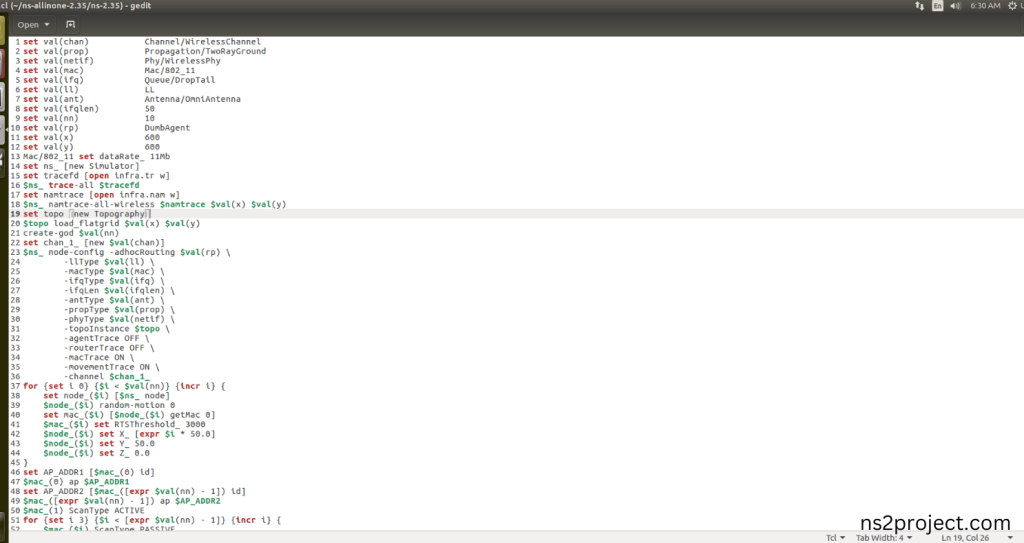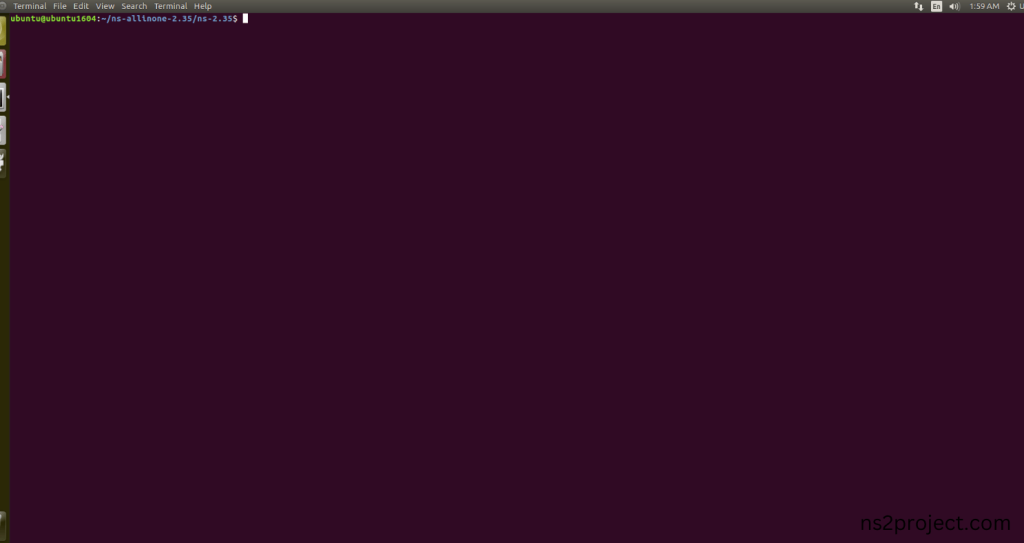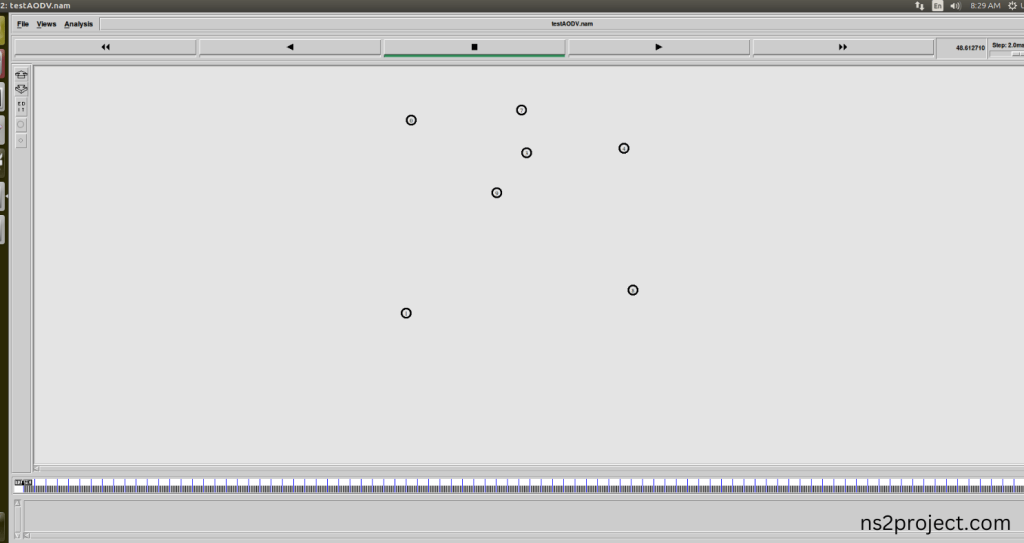How to Install MOBILE NODE.H Packages in Ns2
To import the mobilnode.h packages in NS2, please review the concepts we’ve shared and feel free to gather innovative research ideas from us. To get more research details on mobilnode.h packages in ns2tool our team will help you with best outcomes.
MobileNode.h plays a crucial role in simulating mobile nodes within wireless and mobile ad hoc network settings. It models the behavior of nodes that traverse the simulation area, engaging with other nodes through wireless communication. This file encompasses class declarations and methods that manage mobility, radio propagation, and interactions among nodes in a dynamic environment. The MobileNode incorporates various components, such as defining movement patterns within the simulation space, enabling users to replicate different mobility scenarios, including random waypoint mobility or tailored trajectories. It interacts with both the physical layer and the MAC layer to emulate packet transmission and reception as nodes navigate. Additionally, it collaborates with routing protocols to facilitate route discovery and maintenance in mobile networks. Key features of the MobileNode include tracking and updating node positions, managing handoffs when a node transitions out of one access point’s range and into another’s, and adapting to changes in topologies and connectivity due to node movement. A mobile node is instantiated, its position established within the simulation area, and then assigned a destination and speed through the setdest method, effectively simulating mobility.
PRE-REQUISITES:
Fresh installation of Ubuntu 16.04 LTS:
Screenshot:

2.NS-2.35 Installation:
Screenshot:

Here, Percentage (%) symbol Denotes the successful installation of the NS 2.35 Simulator.
Screenshot:

HEADER FILE VERIFICATION:
- Locate to the ns-2.35 folder:
Screenshot:

2.Create the Main.tcl file in the scratch folder:
Next we need to create the Main.tcl file by using text editor in the ns-2.35 folder.
Screenshot:

Next we need to paste the below code to the Main.tcl file and save the file in the ns-2.35 folder.
Code:
set val(chan) Channel/WirelessChannel
set val(prop) Propagation/TwoRayGround
set val(netif) Phy/WirelessPhy
set val(mac) Mac/802_11
set val(ifq) Queue/DropTail/PriQueue
set val(ll) LL
set val(ant) Antenna/OmniAntenna
set val(ifqlen) 50
set val(nn) 10
set val(rp) AODV
set val(x) 500
set val(y) 400
set val(stop) 150
set ns [new Simulator]
set tracefd [open testAODV.tr w]
set namtrace [open testAODV.nam w]
$ns trace-all $tracefd
$ns namtrace-all-wireless $namtrace $val(x) $val(y)
set topo [new Topography]
$topo load_flatgrid $val(x) $val(y)
create-god $val(nn)
# Node configuration for mobile nodes
$ns node-config -adhocRouting $val(rp) \
-llType $val(ll) \
-macType $val(mac) \
-ifqType $val(ifq) \
-ifqLen $val(ifqlen) \
-antType $val(ant) \
-propType $val(prop) \
-phyType $val(netif) \
-channelType $val(chan) \
-topoInstance $topo \
-agentTrace ON \
-routerTrace OFF \
-movementTrace ON \
-energyModel “EnergyModel” \
-initialEnergy 1000.0 \
-rxPower 0.3 \
-txPower 0.6 \
-idlePower 0.1
for {set i 0} {$i < $val(nn)} {incr i} {
set node_($i) [$ns node]
$node_($i) set X_ [expr 10+round(rand()*480)]
$node_($i) set Y_ [expr 10+round(rand()*380)]
$node_($i) set Z_ 0.0
}
for {set i 0} {$i < $val(nn)} {incr i} {
$ns at [expr 15+round(rand()*60)] \
“$node_($i) setdest [expr 10+round(rand()*480)] [expr 10+round(rand()*380)] [expr 2+round(rand()*15)]”
}
$ns at 10.0 “$node_(0) setdest 250.0 250.0 3.0”
$ns at 15.0 “$node_(1) setdest 45.0 285.0 5.0”
$ns at 70.0 “$node_(2) setdest 480.0 300.0 5.0”
$ns at 20.0 “$node_(3) setdest 200.0 200.0 5.0”
$ns at 25.0 “$node_(4) setdest 50.0 50.0 10.0”
$ns at 60.0 “$node_(5) setdest 150.0 70.0 2.0”
$ns at 90.0 “$node_(6) setdest 380.0 150.0 8.0”
$ns at 42.0 “$node_(7) setdest 200.0 100.0 15.0”
$ns at 55.0 “$node_(8) setdest 50.0 275.0 5.0”
$ns at 19.0 “$node_(9) setdest 250.0 250.0 7.0”
set tcp [new Agent/TCP/Newreno]
$tcp set class_ 2
set sink [new Agent/TCPSink]
$ns attach-agent $node_(2) $tcp
$ns attach-agent $node_(9) $sink
$ns connect $tcp $sink
set ftp [new Application/FTP]
$ftp attach-agent $tcp
proc plotWindow {tcpSource file} {
global ns
set time 0.01
set now [$ns now]
set cwnd [$tcpSource set cwnd_]
puts $file “$now $cwnd”
$ns at [expr $now+$time] “plotWindow $tcpSource $file”
}
proc stop {} {
global ns tracefd namtrace
$ns flush-trace
close $tracefd
close $namtrace
exec nam testAODV.nam &
exit 0
}
$ns at 10.0 “$ftp start”
$ns at $val(stop) “stop”
$ns run
Screenshot:

3.Open the Terminal:
Next, we need to launch the terminal by right clicking the mouse in the ns-2.35 location.
Screenshot:

Screenshot:

4.NS-2.35 Configuration && Building Process:
Next, we need to configure and build the ns-2.35 folder to make the Created files need to work in ns-2.35 configuration.
Command: “./make”
Screenshot:

Screenshot:

Screenshot:

Here, NS-2.35 Building process completed successfully.
5.Importing Mobilenode.h:
Here we imported the Mobilenode.h header file code indirectly accessed the Mobilenode class used in the Tcl script that we had highlighted lines are used for simulating the behaviour of a node that can move across the simulation area, interacting with other nodes through wireless Network communication in this example program. Here we highlighted the code line that highlighted which is internally accessed Mobilenode.h, we will show class file that used in this code via Common folder.
Screenshot:

Screenshot:

Here we will show the header file by opening Mobilenode.h file to show the class or function imported from the Mobilenode.h in the example code. This Tcl Script Line are used for simulating the behaviour of a node that can move across the simulation area, interacting with other nodes through wireless Network communication in this example program.
Screenshot:

Screenshot:

6.Executing the Example Program for Mobilenode Header:
Then we need to run the Example program for Mobilenode Header to view output of the program.
Command: “./ns Main.tcl”
Screenshot:

Here we shown the output of the example program by using Mobilenode.h.
Screenshot:

Screenshot:

Screenshot:

In the NS 2.35 Simulation Example Program, the Mobilenode.h Header file is successfully imported.







